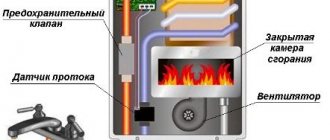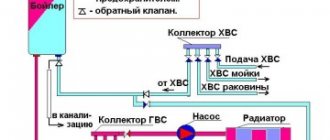Gas boilers are simple and easy to use, do not cause problems during maintenance, and effectively cope with their functional task. They are bought much more often than their electric and solid fuel counterparts, but not everyone knows that before turning on a gas boiler in an apartment or private house, preparatory measures need to be carried out.
In the article we present you will find useful information about starting a gas unit and the rules for preparing it for the upcoming work. We will talk about the features of filling the heating circuit with water. We'll show you how to enable and select the settings you need.
Preparatory stage
The correct solution to the question of how to light a gas boiler should begin with checking the connection according to the diagram of all necessary equipment - this is:
- Pipeline decoupling.
- Batteries, heated floors, boiler and other consumers.
- Pumps.
- Expansion tank.
- Filtration installations.
- Thermal sensors.
- Control, monitoring and safety unit.
- Uninterruptable power source.
Installation, connection and testing of the system before a test run is carried out according to the following algorithm:
- A separate branch of the electrical network for the unit is being installed.
- The place where the boiler is installed is checked. The device should be placed at the recommended distance from the wall, window and door to avoid malfunction due to cooling and drafts. The base must be strong and perfectly level, verified by the building level. There should be no flammable materials or substances located nearby.
- The unit is connected to the water supply. The equipment pipes are freed from plugs and connected to the piping using filter modules with ball valves.
Connecting a gas boiler to pipelines Source utepleniedoma.com
- A gas pipeline is connected from the central gas main. The procedure is always carried out by gas service specialists, followed by installation of a meter with a seal.
- The chimney is connected and its draft characteristics are checked.
When all elements are connected, the unit is de-energized and, together with the system, is filled with coolant. After this, the equipment and pipes are checked for leaks. Then the thermostat is turned to the maximum level - as a result, the indication of switching operating modes should turn on.
See also: Catalog of companies that specialize in the design and installation of fireplaces and stoves
Types of liquids: which is better to use
The heating system is filled with different coolants:
- water;
- antifreeze;
- antifreeze.
These are the main liquids.
Water
A popular type of liquid for filling a heating system. Advantages:
- good heat capacity, ensuring an uninterrupted cycle of heat supply to the room, even when it is frosty outside;
- low viscosity has a positive effect on pump operation and experiences low load. The advantage indicates the durability of the unit;
- low coefficient of expansion of water when heated, installation of a large expansion tank is not required, a small design is sufficient;
- safety;
- availability.
Heating system
Disadvantages:
- When a resource enters the system, oxygen enters the communications along with the liquid—the cause of corrosion.
Corrosion occurs only on metal pipes. If there are plastic communications in a house or apartment, the resource will not cause harm.
Antifreeze
Many people choose antifreeze instead of water. For normal operation, the filler of a heating device must have the following qualities:
- high percentage of heat transfer;
- preservation of physical and chemical properties;
- the liquid should not leave scale in the inside of the pipes;
- should not freeze during frosts.
The water does not meet all the characteristics, becomes a source of scale formation due to the breakdown of salts, and freezes in frosts if the heating system is not started in time. Antifreeze does not freeze at low temperatures and retains its properties inside the communications coming from gas equipment.
Antifreeze is usually mixed with water. The ratio of liquids depends on the equipment parameters and climate. Mix the composition in the following concentrations:
- at temperatures of -40, +115 degrees Celsius, it is necessary to dilute in a ratio of 50 to 50;
- if the temperature is -60 - +135 degrees, you need to fill the system with 30% water, 70% antifreeze.
Antifreeze for filling
Advantages:
- protection of communications from the possibility of corrosion;
- antifreeze breaks down byproducts formed from heating;
- Due to the consistency of the coolant, the solution protects gaskets and synthetic structural elements.
Before choosing antifreeze to fill the communications of a double-circuit unit, it is necessary to study in detail the requirements and technical characteristics of the heating device.
Filling with coolant
The only sure way to turn on a Danko gas boiler or analogs from other manufacturers is to strictly follow all the rules of connection technology. The first thing to do, when all the equipment has been assembled and checked, is to fill the system with coolant - most often water.
Connecting the unit to the water supply Source strojdvor.ru
The procedure is performed according to the following algorithm:
- The valve of the pipe, designed to supply coolant to the system, opens. This unit is usually located at the bottom of the unit, but some models may have a different device. Therefore, before starting filling, it is necessary to check the technical documentation.
- The circuit, pipeline, tank and batteries are filled with coolant over a certain period of time.
- As the system fills, the pressure is monitored using a pressure gauge. The indicator must comply with the manufacturer's recommendations. Typically, its value varies between 1.5-3 atm, but not higher than the maximum level.
- When the required pressure in the system is reached, the supply of coolant stops - the valve closes.
Monitoring pressure parameters in the system Source termopaneli59.ru
Note! If the system is open, it is better to fill it through the expansion tank. However, you need to know in advance how much coolant will be required. Therefore, the preliminary task of solving the question of how to turn on the boiler should be the correct calculation of the total volume of liquid being poured. Its value consists of the capacity of the heating circuit, expansion tank, pipes, batteries, boiler and other consumers.
Checking heating system elements
Without the correct functioning of all components of the heating system, it will not be possible to start it correctly. First of all, you need to check the operation of measuring devices - thermometers and pressure gauges.
It is also necessary to check the functioning of the protective elements. The system may not start if the bleed valve or air vent seats do not move due to limescale or rust. For this reason, each of them is opened manually.
The pressure of the air chamber controls the expansion tank; it must exceed the nominal value in the system by 5-7%. If the design of the tank allows you to change the membrane, it should be disassembled and checked in what condition it is.
The cost of the service for launching a heat supply system in a private household depends on many factors and is determined individually.
Removing air pockets
No matter how carefully the system is filled, air pockets will inevitably form in it. Therefore, the next stage in solving the question of how to ignite the boiler is bleeding the air. It is performed according to the following scheme:
- Air is sequentially bled from the radiators, starting from the top to the bottom. Special valves are opened one by one - as a rule, these are Mayevsky taps - until coolant begins to flow from them.
- Next, the procedure is transferred to the circulation pump.
- The panel on the front side is removed from the unit and a cylindrical element with a slot for a flat slot is found. The cover is loosened by turning the fasteners with a screwdriver.
Bleeding air from the circulation pump Source ytimg.com
- The boiler starts and heating is established - at the same time the pump should begin to emit a buzzing and hissing sound - indicating the presence of air pockets.
- When water begins to exit the cylindrical element, its lid tightens. Then the procedure is repeated 2-3 more times.
- Then it closes and the front panel is assembled.
Further, before starting the gas boiler, the system must be supplemented with coolant. Since during the procedure of bleeding the air plugs, its partial loss occurred.
Pressure testing and flushing procedures
The essence of the next stage - pressure testing - is to pump coolant into the system in order to identify its weak points, where leaks are most likely to occur during further operation. It is performed using special pumping equipment at intervals of about 10 minutes.
In this case, the pressure gauge readings must be constantly monitored. If the pressure drops, it means there is depressurization. You need to find the problem and fix it.
Pressure testing of gas boiler equipment Source gradusplus.com
The second important procedure of this stage is washing. This is essentially cleansing the system of sediment, rust and other foreign particles inside the pipes, circuit and radiators. Before lighting a Danko boiler or an analogue of another line, open all the taps on the radiators and let in water under a pressure slightly higher than the operating parameters - about 4 atm. Upon completion of washing, the filter units must also be replaced or cleaned.
Inclusion
The startup algorithm depends on the type of unit installed. For the mounted version, the diagram looks like this:
- The power supply is connected.
- Gas is supplied.
- The start key is pressed.
- The operating temperature range is set.
- When the system is equipped with an electronic type of burner, the first start of heating is carried out automatically, and if there is piezo ignition, after pressing the corresponding button.
Connecting a wall-mounted gas boiler Source otoplenie-gid.ru
Floor-standing equipment is turned on according to the following instructions:
- The control and temperature module is switched to the on position.
- The gas supply valve opens.
- Piezo ignition is set on the temperature selector.
- In accordance with the manufacturer's instructions, the piezo button is pressed.
- The heating value is adjusted.
Important! Before turning on a floor-standing AGV, as well as a similar boiler from another manufacturer, you need to completely ventilate the boiler room, make sure the draft is working properly and open the door.
Connecting a floor-standing gas boiler Source ogvk.ru
Possible breakdowns of a gas boiler
There is such a problem: after you release the start button, the igniter goes out. This malfunction is associated with a breakdown of the gas boiler automation system. But under no circumstances should you use the boiler with the automation switched off. This is due to the fact that if the flame goes out due to a strong air flow or if the gas supply is unexpectedly stopped, the gas supply may begin to flow into the room.
The automation system circuit consists of a draft sensor, a valve, an electromagnet and a thermocouple. In order to turn on the igniter, you must press the start button. A rod, which is connected to a button, presses on the valve membrane, and gas flow to the igniter begins. Then the igniter is lit.
Thus, the igniter flame begins to come into contact with the thermocouple. The thermocouple heats up in 30-40 s, and an emf appears at its terminals. It is enough to trigger the electromagnet. Thus, the rod is fixed in the lower position. After this, you can release the start button.
The draft sensor is located in the upper part of the gas boiler, next to the pipe for discharging combustion products into the environment. Such a device consists of a contact and a bimetallic plate.
If a pipe becomes clogged, its temperature rises sharply. The bimetallic plate begins to heat up and the voltage supply circuit to the electromagnet breaks. Thus, the stem cannot be held by the electromagnet and the valve closes. This means the gas supply will stop.
Possible problems
Often, even with strict compliance with all the requirements of the preparation technology and startup stages, the following series of equipment operational problems may arise:
- The igniter does not work. The probable cause is clogging and plaque formation. Needs cleaning. Thermocouple, solenoid valves, or supply valves may also be damaged. Needs repair or replacement.
- There is a popping noise when the main burner fires . Before turning on the gas boiler, the igniter center must be adjusted to the height of the flame, as it may be lower than the main burner. There may also be excessive pressure coming from the gas line. Another reason is a clogged or malfunctioning electrode in the electronic ignition system.
Video description
Video instructions for starting a gas boiler:
- Timing. To eliminate excessive fuel consumption, it is necessary to adjust the gas supply intensity using the control module according to the instructions.
Helpful information! The first time after startup, the heating will inevitably work with a certain amount of air, which in practice will be manifested by characteristic sounds. Since it is impossible to remove all the air from the system. However, over time, this effect will disappear due to the operation of the bleed valve on the expansion tank. The main thing is to periodically check the pressure; it should be within the recommended range.
Briefly about the main thing
Before lighting a gas boiler, it is necessary to perform a number of preparatory procedures:
- Connect and check the equipment.
- Fill with coolant.
- Eliminate air pockets.
- Carry out pressure testing and flushing of the system under the action of a pressure pump.
Next, in accordance with the manufacturer’s instructions and recommendations, the unit is started for the first time. During operation, it is necessary to monitor the operation of the boiler and the system, and in case of failure, promptly correct the malfunction.
Ratings 0
Winter launch features
If you have to start the boiler in winter, you will need to slightly change the sequence of work:
- it is necessary to warm the premises to above-zero temperatures using electric heaters;
- fill the short circuit closest to the boiler with coolant;
- warm up the coolant to a temperature of 20-23 degrees (no more);
- gradually move further along the circuits, heating the coolant to the above temperature;
- after all circuits are filled, you can turn on the unit in operating mode.











